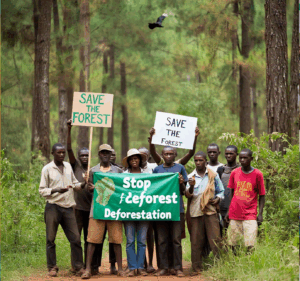“One of the first conditions of happiness is that the link between man and nature shall not be broken”
——– Leo Tolstoy, Russian Writer and Religious Thinker

Environmental activism refers to collective efforts and activities to protect the natural environment, promote sustainable development, and address environmental issues such as climate change, pollution, deforestation, and biodiversity loss.
The movement employs multiple strategies, including grassroots mobilization, policy advocacy, public awareness campaigns, and intervention (Fisher et al., 2020; UNEP, 2022). Environmental activists typically aim to influence political, economic, and social structures to improve ecological health and provide justice for future generations (IPCC, 2021).
Key aspects include:
- Goals
- Mitigate climate change through emission reductions and renewable energy adoption.
- Protect ecosystems and endangered species.
- Advocate for environmental justice, ensuring marginalized communities disproportionately affected by pollution and climate impacts are prioritized (IPCC, 2021).
- Promote sustainable consumption and production patterns aligned with global frameworks like the United Nations Sustainable Development Goals (SDGs; United Nations, 2015).
- Methods
- Grassroots Campaigns: Community-led initiatives, such as tree-planting drives or anti-plastic movements (Thaker et al., 2019).
- Policy Advocacy: Lobbying governments to enact laws like carbon taxes or bans on single-use plastics (Maibach et al., 2022).
- Public Awareness: Leveraging media, art, and education to foster eco-conscious behaviours (UNEP, 2022).
- Direct Action: Protests, strikes, and civil disobedience (e.g., Fridays for Future school strikes led by Greta Thunberg (Fisher et al., 2020).
- Stakeholders
- Individuals: Youth activists, scientists, and influencers, raising awareness on social media. Non-Governmental Organizations (NGOs): Groups like Greenpeace and the World Wildlife Fund (WWF), driving global campaigns.
- Governments and International Bodies: Entities such as the United Nations and IPCC shape policy through scientific consensus (IPCC, 2021).
Development communication refers to the strategic use of communication processes to promote advancement in social, political, and economic spheres.
It emphasises the importance of the role of information exchange, media, and participatory dialogue in interactive discussions to tackle systemic issues such as poverty, inequality, health disparities, and environmental degradation (Servaes, 2018).
Grounded in interdisciplinary foundations, development communication draws on concepts from communication studies, sociology, and international development to create targeted strategies for empowering marginalised groups and fostering sustainable change (Melkote & Steeves, 2001). It is applied in health campaigns, environmental advocacy, and policy influence, among others.
Key principles include:
- Participatory approach:
Development communication prioritizes community engagement, ensuring that target audiences co-create solutions rather than passively receiving information. This approach aligns with Freirean pedagogy, which advocates for dialogue as a tool for empowerment (Servaes, 2018).
- Behavioural and Social Change:
It aims to influence individual and collective behaviours through campaigns that promote health practices (e.g., vaccination drives), environmental sustainability (e.g., anti-deforestation messaging), or gender equality (UNESCO, 2017).
- Equity and Inclusion
Programmes often focus on amplifying the voices of marginalized groups, including women, Indigenous communities, and low-income populations, to address power imbalances (Gumucio-Dagron, 2001).
- Multichannel Strategies
Utilises diverse platforms such as radio, television, social media, community theatre, and mobile technologies to maximize reach and cultural relevance (Melkote & Steeves, 2001).
The Interconnection
Environmental activism has become a cornerstone of global efforts to address climate change, biodiversity loss, and pollution.
As crises intensify, development communication, a field that leverages strategic communication to advance social, economic, and political progress, has emerged as a critical tool for mobilizing public engagement, shaping policies, and fostering sustainable behaviours.
Environmental activism leveraging the development communication role helps to push efforts into preserving the environment and making it better for future generations. This interconnection uses various ways to make this happen.
This feature explores how development communication drives environmental activism, examining its role in media, community engagement, policy advocacy, and digital innovation.
- The Power of Media in Environmental Awareness
The media serves as a primary conduit for disseminating environmental messages, bridging scientific knowledge with public understanding. Traditional media (e.g., television, radio) and digital platforms amplify narratives about climate change, deforestation, and renewable energy, often framing these issues as urgent and actionable.
For instance, McComas (2020) highlights how media coverage of extreme weather events, such as hurricanes and wildfires, has heightened public awareness of climate change’s tangible impacts. However, media framing also risks oversimplifying complex issues or amplifying misinformation, underscoring the need for evidence-based communication strategies.
Development communication professionals collaborate with journalists and content creators to ensure accuracy and inclusivity. For example, partnerships between the United Nations Environment Programme (UNEP, 2022) and media outlets have produced documentaries and infographics that contextualize climate data, making it accessible to diverse audiences.
- Community Engagement and Grassroots Mobilization
At the local level, development communication fosters grassroots activism by empowering communities to voice their environmental concerns. Participatory methods, such as community radio, theatre, and workshops, enable marginalized groups to share knowledge and advocate for sustainable practices.
A study by Thaker et al. (2019) found that community-led campaigns in India successfully reduced plastic use by combining traditional storytelling with mobile messaging to educate rural populations.
Grassroots movements like Fridays for Future, initiated by Greta Thunberg, exemplify how youth-driven communication strategies, such as social media hashtags and viral videos, can galvanise global action. Fisher et al. (2020) note that these campaigns leverage emotional appeals and personal narratives to humanise climate science, fostering solidarity across borders.
- Policy Advocacy and Stakeholder Collaboration
Development communication also plays a pivotal role in influencing policymakers by translating research into actionable agendas. NGOs, governments, and international bodies employ targeted messaging to build consensus on environmental policies.
For instance, the Intergovernmental Panel on Climate Change (IPCC, 2021) uses plain-language summaries and infographics to communicate climate risks to lawmakers, enhancing the likelihood of policy adoption.
Collaborative platforms, such as the Global Climate Observatories, facilitate dialogue between scientists, media, and policymakers, ensuring that communication strategies align with evidence-based targets (UNESCO, 2021). Such initiatives highlight the importance of multilateral cooperation in addressing transnational challenges like ocean plastic and air pollution.
- D. Case Study: Digital Campaigns and Youth Activism
Digital platforms have revolutionized environmental activism, enabling rapid information sharing and mobilization. The Climate Strike movement, which organized over 4 million global participants in 2019, illustrates how social media algorithms can scale grassroots efforts (Fisher et al., 2020). Platforms like TikTok and Instagram also engage younger audiences through short-form videos, memes, and interactive polls, making sustainability relatable.
Ojala (2021) emphasizes the psychological impact of these campaigns, noting that youth activists often employ hope-focused messaging to counter eco-anxiety. For example, the Earth Uprising podcast blends storytelling with expert interviews, inspiring listeners to adopt plant-based diets or participate in tree-planting initiatives.
Challenges and Ethical Considerations
Despite its potential, development communication faces hurdles. Misinformation, such as climate denialism, spreads rapidly online, undermining trust in science (Maibach et al., 2022). Additionally, disparities in digital access limit the reach of online campaigns in low-income regions. Cultural sensitivity is another concern; Western-centric narratives may clash with Indigenous environmental practices, necessitating localized approaches.
Ethical communication demands transparency, inclusivity, and accountability. For instance, campaigns must avoid “greenwashing,” where corporations exaggerate eco-friendly practices without substantive action (Smith & Leiserowitz, 2023).
Future Directions: Innovation and Equity
Emerging technologies, including artificial intelligence (AI) and virtual reality (VR), offer new avenues for immersive environmental storytelling. AI-driven analytics can personalize climate messaging, while VR experiences simulate the impacts of deforestation or sea-level rise, fostering empathy (UNEP, 2022).
Equity remains central to future efforts. UNESCO (2021) advocates for education programs that integrate climate literacy into school curricula, ensuring marginalized communities gain the tools to advocate for their rights. Global partnerships, such as the Paris Agreement’s public awareness initiatives, underscore the need for cross-cultural collaboration.
Conclusion
Development communication is indispensable in advancing environmental activism, from local grassroots efforts to global policy frameworks. By harnessing media, digital tools, and ethical storytelling, communicators can bridge the gap between science and society, fostering collective action. As climate challenges evolve, innovation and equity must guide communication strategies to ensure a sustainable future.
References
Fisher, D. R., Lorenz, J., & Najam, A. (2020). What did Greta do? Analyzing the relationship between the Fridays for Future movement and climate policymaking in Germany. Global Environmental Politics, 20(3), 34–52. https://doi.org/10.1162/glep_a_00565
Intergovernmental Panel on Climate Change (IPCC). (2021). Climate change 2021: The physical science basis. Cambridge University Press.
https://www.ipcc.ch/report/ar6/wg1/ (Accessed May 3, 2025)
Maibach, E. W., Chuk, M., & Nisbet, M. C. (2022). Strategic climate communications and social movements: Lessons from 50 years of U.S. environmental advocacy. Annual Review of Environment and Resources, 47, 593–618. https://doi.org/10.1146/annurev-environ-012021-024535
McComas, K. S. (2020). Media coverage of climate change. In R. L. Heath & H. D. O’Hair (Eds.), Handbook of risk and crisis communication (pp. 322–339). Routledge.
Ojala, M. (2021). Youth activism on climate change: Engaging in an existential threat. Journal of Applied Developmental Psychology 77, 101330.
https://doi.org/10.1016/j.appdev.2021.101330
Smith, N., & Leiserowitz, A. (2023). The rise of climate activism. In Oxford Research Encyclopedia of Climate Science. Oxford University Press.
https://doi.org/10.1093/acrefore/9780190228620.013.23
Thaker, J., Smith, N., & Leiserowitz, A. (2019). Climate change communication in India. Palgrave Communications, 5(1), 1–10. https://doi.org/10.1057/s41599-019-0247-7
United Nations Educational, Scientific and Cultural Organization (UNESCO). (2021). Education for sustainable development goals: Learning objectives. UNESCO Publishing. https://unesdoc.unesco.org/ark:/48223/pf0000379335
United Nations Environment Programme (UNEP). (2022). The environmental pulse of social media. UNEP. https://www.unep.org/resources (Accessed May 3, 2025)
About the Writer
Ebenezer specializes in Development Communication and has research interests in Sustainability, Climate Communication, Development Studies, and Green Economy. Connect with him via: [email protected] / [email protected]
LinkedIn: Ebenezer Asumang. [ https://www.linkedin.com/in/ebenezer-asumang/ ]










